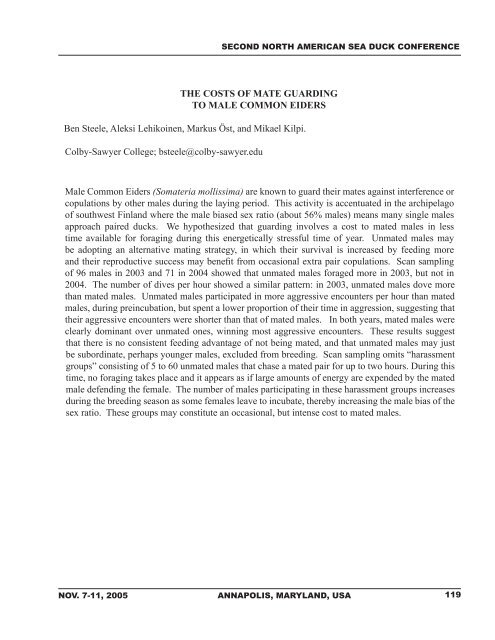Second North American Sea Duck Conference - Patuxent Wildlife ...
Second North American Sea Duck Conference - Patuxent Wildlife ...
Second North American Sea Duck Conference - Patuxent Wildlife ...
You also want an ePaper? Increase the reach of your titles
YUMPU automatically turns print PDFs into web optimized ePapers that Google loves.
SECOND NORTH AMERICAN SEA DUCK CONFERENCE<br />
THE COSTS OF MATE GUARDING<br />
TO MALE COMMON EIDERS<br />
Ben Steele, Aleksi Lehikoinen, Markus Öst, and Mikael Kilpi.<br />
Colby-Sawyer College; bsteele@colby-sawyer.edu<br />
Male Common Eiders (Somateria mollissima) are known to guard their mates against interference or<br />
copulations by other males during the laying period. This activity is accentuated in the archipelago<br />
of southwest Finland where the male biased sex ratio (about 56% males) means many single males<br />
approach paired ducks. We hypothesized that guarding involves a cost to mated males in less<br />
time available for foraging during this energetically stressful time of year. Unmated males may<br />
be adopting an alternative mating strategy, in which their survival is increased by feeding more<br />
and their reproductive success may benefit from occasional extra pair copulations. Scan sampling<br />
of 96 males in 2003 and 71 in 2004 showed that unmated males foraged more in 2003, but not in<br />
2004. The number of dives per hour showed a similar pattern: in 2003, unmated males dove more<br />
than mated males. Unmated males participated in more aggressive encounters per hour than mated<br />
males, during preincubation, but spent a lower proportion of their time in aggression, suggesting that<br />
their aggressive encounters were shorter than that of mated males. In both years, mated males were<br />
clearly dominant over unmated ones, winning most aggressive encounters. These results suggest<br />
that there is no consistent feeding advantage of not being mated, and that unmated males may just<br />
be subordinate, perhaps younger males, excluded from breeding. Scan sampling omits “harassment<br />
groups” consisting of 5 to 60 unmated males that chase a mated pair for up to two hours. During this<br />
time, no foraging takes place and it appears as if large amounts of energy are expended by the mated<br />
male defending the female. The number of males participating in these harassment groups increases<br />
during the breeding season as some females leave to incubate, thereby increasing the male bias of the<br />
sex ratio. These groups may constitute an occasional, but intense cost to mated males.<br />
NOV. 7-11, 2005 ANNAPOLIS, MARYLAND, USA<br />
119












